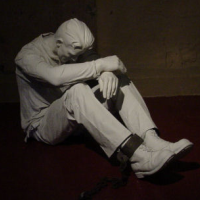Federal Judge Gives Class-Action Status to California Prisoners Protesting Solitary Confinement

An estimated 29,000 California inmates participated in a hunger strike last year over prison conditions, in general, and solitary confinement, in particular. After two months, the confrontation generated a lot of attention from the public and promises of more attention from politicians, but few immediate changes of consequence.
On Monday, a federal judge gave prison reform advocates a little something more tangible when she granted class-action status to a lawsuit brought by 10 inmates at the notorious Pelican Bay State Prison in Northern California. U.S. District Judge Claudia Wilken allowed upward of 500 prisoners who have been in isolation there for more than 10 years, with no end in sight, to join the lawsuit (pdf) brought by the Center for Constitutional Rights.
The suit alleges that prolonged solitary confinement violates the Eighth Amendment to the Constitution, which prohibits cruel and unusual punishment. In addition to isolation in a cramped, concrete, windowless cell with no access to visits, vocational training or educational programs, prisoners in the Security Housing Unit (SHU) have no reasonable way to get out.
Placement in an SHU is technically reviewed every six years, but prisoners are, for all intents and purposes, permanently isolated, the lawsuit claims. A prisoner does not have to have committed an offense to be there; simply being labeled a gang affiliate will do. More than 200 of the Pelican Bay prisoners in isolation have been there for more than 15 years and 78 for more than 20 years.
“We pose a fundamental question: Is it constitutional to hold someone in solitary confinement for over a decade,” Alexis Agathocleous, staff attorney for the center told the Los Angeles Times.
Many of the prisoners are isolated because they are gang members or thought to be gang members. The suit does not include those among the prison’s 1,000 isolated prisoners who have been accepted into the state’s “Step Down” program, a pilot program, extended after the hunger strike, which integrates them back into the general population.
Prison-rights advocates describe it as a cumbersome, limited process that can take an average of four years to complete. It is effectively not available to avowed gang members.
Legislation that would have extended step-down in facilities with SHU to gang members, AB 1652, failed in the Assembly last week. Another bill, Senate Bill 892, is more comprehensive in its approach and outlines a process for review of all prisoners in isolation, but requires a renouncement of gang affiliation. It cleared the Senate last week and is headed for the Assembly.
Published accounts of how many of California’s 125,000 prisoners languish in isolation vary widely, from 3,000 to 12,000. A 2012 report from Amnesty International said, “No other US state is believed to have held so many prisoners for such long periods in indefinite isolation,” and they came in on the low side.
–Ken Broder
To Learn More:
Judge Grants Class Action Status to Inmates' Solitary Confinement Case (by Paige St. John, Los Angeles Times)
Hundreds of California Prisoners in Isolation to Join Class Action Lawsuit (Center for Constitutional Rights)
Hunger Strike Sparks California Prison Reform Efforts (by Matthew Heller, MintPress News)
Amnesty International Condemns California Prisons’ Use of Indefinite Isolation (by Ken Broder, AllGov California)
UN Wants to Investigate California Prisons for Torture (by Ken Broder, AllGov California)
Ashker v. Brown (U.S. District Court Northern District of California) (pdf)
- Top Stories
- Controversies
- Where is the Money Going?
- California and the Nation
- Appointments and Resignations
- Unusual News
- Latest News
- California Forbids U.S. Immigration Agents from Pretending to be Police
- California Lawmakers Urged to Strip “Self-Dealing” Tax Board of Its Duties
- Big Oil’s Grip on California
- Santa Cruz Police See Homeland Security Betrayal in Use of Gang Roundup as Cover for Immigration Raid
- Oil Companies Face Deadline to Stop Polluting California Groundwater





